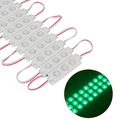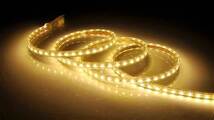Understanding LED strip technical elements
LED strips are a flexible and easily installed way of completely changing the ambience of a space, and can play a major role in converting a fairly bland environment into one with an incredible amount of character. However, few people know the technical ins and outs of their LED strips, what they consist of, or even what makes a good LED strip good.
Read on to find more about the technical side of LED strips, and see how you can make the most of the LED strips in your home. In this guide:
Power supply
LED density
Lumens
Frequently asked questions
Power supply
All LED strips run on direct current (DC) rather than alternating current (AC), the electricity that comes out of the plug is AC so it is very important to use a DC power supply when using LED strip. Put simply, with an AC power supply the electrical current continually reverses directions, which makes it easier to scale up to large voltages. This is why AC is used in homes and business internationally. DC is used by smaller devices, including torches, mobile phone chargers, and most relevant in this case, LED strips. The reason DC isn't used in the national grid is that the wires' internal temperatures would soar, making it unsafe for mass use.
Due to the use of DC current in LED strips, you would need a transformer to convert an AC into a power supply you could use. A good transformer will ensure that your LED strip has its wattage and voltage needs met consistently and can keep your strip light at a consistent level of illumination by avoiding voltage drop.
LED density
When you're looking for a high-quality light strip that offers brightness that can challenge many lamps and fluorescent lights, you'll be looking for a high level of LED density.
The LED density is the amount of LED emitters per metre, and determines the average distance between LEDs in your length of strip. Higher density LED strips will ensure a more complete light coverage and can offer significantly higher light output. To ensure that you're reaching a reasonable level of brightness having a good amount of LEDs per metre is ideal.
In addition to light output, the LED density of your strip light can determine the power consumption. The current draw is a major aspect of the amount of power that will be used by your LED strip light, so you'll need to strike a fine balance in the LED density you use. If your budget is tight and you're keeping an eye on your bills, it might be better finding a compromise that sacrifices some LED density in exchange for not using an excessive amount of power.
You can select a medium-density LED strip in order to guarantee a good level of coverage without running the risk of your costs running high. LED strip lights tend to be cheap to run in any case, but you can make a small saving by using a slightly lower density that still offers quality.
Finally, you can divide the wattage per metre your strip uses by the LED density per metre. Your LEDs shouldn't be using more than 0.2 watts each, and using more power than this runs the risk of harming the longevity of the individual LED emitters within your strip.

Lumens
Lumens are the unit used to measure the amount of light emitted from a specific source. Strips can be manufactured to have different lumens per metre for varied brightness levels, and this should be taken into consideration when choosing LED strip lighting for different applications. Brightness is defined by a few factors, including the LED density of the strip light, the power draw of the LED strip and the efficiency and output per LED emitter.
Most good LED strips can produce a bright enough light to compete with standard incandescent bulbs and fluorescent lamps without any significant issues. A strip with over 850 lumens per metre such as the Classic 120 LED Strip in 12v will emit a crisp light ideal for lighting the home and workspaces, whereas the Water Resistant 60 LED Strip in 12v is 420 lumens per metre and much softer, making it better for accent lighting and other highlights.
One major red flag is an LED strip that doesn't advertise how bright it is, with another worry being a cheap LED strip that claims to provide a high level of brightness. This is often because they're overworking the individual LEDs, which can lead to the diodes struggling early into their estimated life span.
In addition to pure brightness, RGB strip lights benefit from variable colour temperature and brightening and dimming features. You can significantly adjust your room's lighting to be perfect for your specific tastes.
Frequently asked questions
What is voltage in an LED strip?
Our LED strip runs are available in 5v, 12v or 24V direct current, transformed from a mains connection to ensure that your strip doesn't have issues with voltage drop and doesn't suffer from dimness. Read our guide to LED strip voltage options for more information.
How do you connect LED strips?
LED strips are easy to connect and hang up. The copper markers which indicate cut points on a length of LED strip also indicate a connector where you can input the power source. To find out more about cutting, connecting and installing LED strips, check out our guide here.
What LED strip light colour options are available?
Our LED strips are available in a range of single colours, including red, green, blue and yellow. This is in addition to RGBW and RGB LED strip options, which are highly versatile and can create a full spectrum of colours at several colour temperatures





